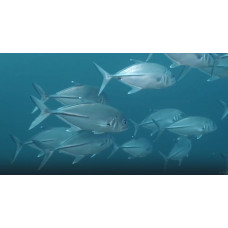Latin name
Caranx sexfasciatus
Other names
Bigeye jack, great trevally, six-banded trevally, dusky jack.
Identification
They have an elongated, slightly compressed body covered with small cycloid scales. The thorax is completely covered with scales. The upper body profile is slightly convex anteriorly; gradually rising from the tip of the snout to the beginning of the base of the second dorsal fin. Lower body profile slightly convex. The snout is slightly pointed, the length of the snout exceeds the diameter of the eyes. The tip of the upper jaw extends to a vertical line passing through the end of the eye. Eyes with thick eyelids; in the anterior part of the eye the eyelid is small and in the posterior part it reaches the posterior edge of the pupil. The first gill arc has 21-25 gill stamens, of which 6-8 on the upper part and 15-19 on the lower part. The lateral line forms a high arch anteriorly and then continues straight to the caudal peduncle. The curved part of the lateral line has 49-50 scales; the straight part has 0-3 scales and 27-36 bony flaps. Vertebrae: 10 trunk vertebrae and 15 tail vertebrae.
Teeth
Teeth on upper jaw arranged in two rows; anterior row strong, widely spaced, fanglike; inner row small, villous. Teeth on lower jaw arranged in one row; strong, conical, widely spaced in adults.
Features of fish fins
Two dorsal fins. The first dorsal fin has 8 hard rays and the second has 1 hard ray and 19-22 soft rays. The anal fin has 1 barbed ray and 14-17 soft rays, with 2 barbs in front of the fin. The anterior soft rays in the dorsal and anal fins are elongated. Pectoral fins are elongated, crescent-shaped. Pelvic fins have 1 hard and 19-22 soft rays. Caudal fin sickle-shaped.
Fish colouring
In adults, the upper part of the head and body is silvery-olive to iridescent blue-green, the lower part of the body is silvery-olive or whitish. There is a small dark spot near the upper edge of the gill cover, the diameter of the spot is much smaller than the diameter of the pupil. The second dorsal fin is olive to blackish with a white anterior tip. The anal and caudal fins are yellowish or black. Lateral line shields are dark or black. In juveniles and young individuals, the head, body, and shields are more silvery, and the fins are gray to yellowish. The upper half of the anterior part of the dorsal fin and the upper lobe of the caudal fin are dark. On the sides of the body there are 4-7 broad dark transverse stripes.
Distribution
Widely distributed in the temperate, subtropical and tropical waters of the Indo-Pacific and eastern Pacific. Indian Ocean: from the southern tip of Africa along the east coast of Africa to the Red Sea and Persian Gulf. Occurs along the entire coast of South and Southeast Asia to Indonesia and northern and western Australia. Also found off hundreds of oceanic islands in the Indian Ocean, including the Maldives, Seychelles, Madagascar, and Cocos Islands. Western Pacific: from south of Japan; on all islands and archipelagos of the central western Pacific and south to the east coast of Australia and New Caledonia. Eastern Pacific: from Mexico and the Gulf of California to Ecuador, including the Galapagos and Hawaiian Islands.
Habitat
Marine, freshwater, brackish, reef-dwelling, amphidromous tropical species. Prefers temperatures from 26°C to 29°C and depths from 0 to 146 m.
Size
Maximum body length 120 cm, usually up to 60 cm. Body weight up to 18 kg.
Behavior
Adults live in coastal and oceanic waters associated with reefs. They are often seen in large schools during the day, but are solitary feeders at night. During the day, they are usually seen in stationary aggregations, forming slow-moving schools in passages or outside the reef. Juveniles can be found in estuaries, sometimes entering rivers and penetrating far inland.
Food and feeding habits
Adults feed mainly on fish, squid and crustaceans.
Reproduction
Fish spawn several times a year. Fecund. Females lay about a million eggs at a time. Parents do not hide them or monitor their offspring. Eggs float freely in the water column. Some are eaten, and some produce fry. The first time they hide in the "shadow" of jellyfish. As they grow up, they go on a solo journey.
Fishing
They are mainly caught with hook and line, but also with gill nets, purse seines and other artisanal gear.
Relationship with a person
It is sold fresh, dried, salted or frozen. It is consumed fried, boiled and baked. There have been reports of ciguatera poisoning.
| Classification | |
| Phylum | Chordata |
| Class | Actinopterygii |
| Squad | Carangiformes |
| Family | Carangidae |
| Genus | Caranx |
| Species | C. sexfasciatus |
| Features | |
| Conservation status | Least Concern |
| Habitat | Pelagic |
| Life span, years | No information |
| Maximum body weight, kg | 18 |
| Maximum length, cm | 120 |
| Sailing speed, m/s | No information |
| Threat to people | Edible |
| Way of eating | Predator |
Bigeye trevally
Tags: bigeye trevally



